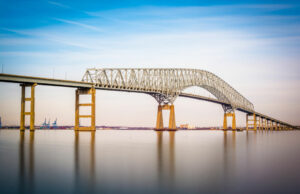
The video and pictures of the tragic collapse of the iconic Francis Scott Key Bridge in Baltimore are horrific. Early on March 27, an enormous cargo ship slammed into a support column of the 1.6-mile-long bridge that runs over a stretch of the Patapsco River, causing a large section of the bridge to collapse into the water.
Six road construction workers who were working on the bridge at the time lost their lives. More lives — including those of the drivers and passengers of vehicles that were halted by authorities minutes before the crash — could have been lost. The ship and debris from the accident block the width of the river and need to be cleared.
An estimated 10,000 port workers and up to another 140,000 other workers associated with the Port of Baltimore, along with multiple businesses in and around the area, will be directly affected by the port’s closure.
The bridge was named after Francis Scott Key, who composed the “Star Spangled Banner.” Construction of the bridge began in 1972 and opened to traffic on March 23, 1977, almost 47 years to the day of last Wednesday’s collapse. The bridge served as a daily commute route for tens of thousands of people over the Patapsco River that weaves through central Maryland into the Chesapeake Bay. Part of the waterway forms the Baltimore Harbor and the city’s main port, which is a major shipping hub along the network of ports on the East Coast of the United States.
The economic reach of the bridge collapse was described by Maryland Gov. Wes Moore as massive: “So this is not just going to have a massive economic impact on the state of Maryland, this is going to hurt the farmer in Kentucky, it’s going to hurt the auto dealer in Michigan. This is going to impact the entire country’s economy.”
Federal and state legislators and authorities reacted quickly to focus on efforts to open the port, replace the bridge and provide needed support for workers and businesses impacted by the tragedy. Hours after the collapse, President Joe Biden promised the federal government would pay to replace the bridge, and he and Transportation Secretary Pete Buttigieg promised to assist the state in resuming port operations.
We will miss the glamour and the majesty of the Key Bridge. It was a tourist high point in any drive around the city of Baltimore. Its distinguishing engineering grandeur — that featured impossibly long, flowing, steel trusses — seemed to defy gravity. But as explained by the experts, each of the bridge’s lengthy spans helped other parts do their work and allowed less steel to bear more weight. But the bridge’s support system couldn’t survive a direct hit by a 200-million-pound cargo ship moving at nearly 10 miles per hour.
We hope the replacement comes soon with new, updated design and engineering features that will add to the beauty of the harbor and provide much-needed transportation support for those living in and passing through Baltimore.





